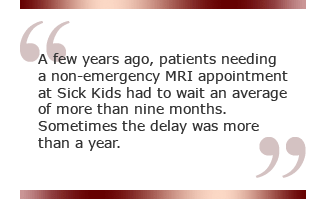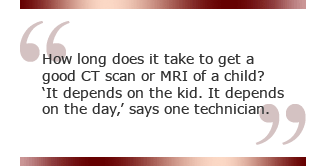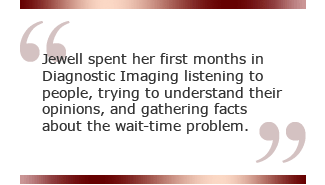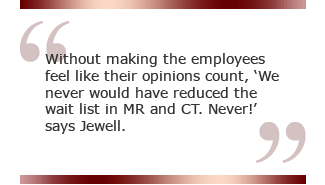The 10-year-old girl carried along a small stuffed cat as technologist Matt Fry escorted her to the large magnetic resonance imaging (MRI) machine. The patient knew the territory. She had a brain tumor removed three years earlier and was what the staff calls a "frequent flier" of the Diagnostic Imaging unit at Toronto's Hospital for Sick Children.
Still, she had been sobbing in the staging area. Fry was ready to offer tissues and some of his tried-and-true reassurances, such as, "It's just a big camera."
 |
"Can I borrow your tiger for just a second?" he said. She reluctantly surrendered it. Fry held it to the side of the MRI machine to ensure it contained no metal and quickly returned it. The technologist invited the girl to climb onto the gurney. "Do you fall asleep sometimes?" he asked. She nodded. "I always fall asleep," he said, hoping to calm her fears by reminding her that he had been in the MRI many times.
Fry gently arranged her on the gurney and asked twice if she was warm enough as he engaged the motors that moved her into the center of the magnetic circle. He positioned the tiger on her stomach so she could see it through the mirror inside the "doughnut."
The technologist backed away to the control room and began the imaging session. "Remember, you will be able to hear me talk to you through the microphone," he told the girl. "She'll be fine," he remarked. "When I left her on the table, she had a big smile on her face."
Technology meets tigers and tears every day at the hospital nicknamed "Sick Kids." The unique challenges of treating seriously ill children mean it often takes a little more -- more explanation, more reassurance, more time.
Time, however, is in short supply. The patients and staff who entered the hospital that day walked past National Post newspaper boxes bearing the lead headline, "Provinces Set New Wait Times: Patients should receive new hip within 6 months, cardiac bypass in 2 weeks." In June 2005, the Supreme Court of Canada ruled that long waits for medical care in Quebec violated that province's charter of rights, intensifying a national debate on the issue.
A few years ago, patients needing a non-emergency MRI appointment at Sick Kids had to wait an average of more than nine months. Sometimes the delay was more than a year. By increasing its hours of operation, refining its patient scheduling and -- maybe most crucial -- fostering an atmosphere of greater respect among the different professions who work in the imaging centers, Sick Kids was able to reduce its average wait time to four weeks. Ensuring that employees knew that their opinions matter was the linchpin to the turnaround, the staff say.
 |
Looking inside
The Hospital for Sick Children is one of the leading pediatric healthcare and research facilities in the world. It employs a staff of more than 5,000, plus another 1,200 in its research institute. It handles more than 90,000 patient days, more than 23,000 operating room hours, 47,500 visits to the emergency room, and more than 300,000 visits by patients who don't need to be admitted for a hospital stay. The government-run hospital spent $538 million (CAN) in its 2004/2005 fiscal year.
Although the facility serves the Toronto area, treating relatively minor ailments such as earaches and stitching deep cuts, many of the patients are among Canada's most seriously ill children. A steady procession of heart-wrenching troubles comes through the door. Some are severe traumas, such as a teenaged boy hit by a truck and flown to the hospital. Some have congenital abnormalities, such as a heart on the wrong side of the chest, and some require organ transplants. Others have cancer or are recovering from surgery to remove tumors.
At the beginning and throughout the process, it's crucial that the doctors look inside the bodies of their young charges. The Diagnostic Imaging department brings a number of different technologies to the task, from traditional X-rays to ultrasound to CT (computed tomography) scans and MRIs. The beauty of all the methods is that they allow a detailed view without any incisions. It also means Diagnostic Imaging is under tremendous demand, becomes a bottleneck, and is therefore an area of continuous pressure. "You're not able to do that hip surgery, that oncology treatment, that cardiac surgery, or that ophthalmology work without first having a diagnostic imaging done," says Ellen Charkot, chief technologist and a 30-year employee of the hospital.
 |
Diagnostic imaging requires the combined efforts of at least four types of professionals: nurses, technologists, anesthetists, and radiologists. The coordination of the "techs" and nurses seems to make the greatest difference in increasing patient flow without sacrificing the quality of the images.
Strategies for maximizing production through a bottleneck are well established and taught at most business schools. But those solutions assume a higher degree of control over the "inputs" than children allow. With most adult patients, the process of obtaining scans can be sped up by their understanding of what's required of them. An MRI session can last 30 to 60 minutes, maybe more. The patient must lie still for long stretches of time inside a sometimes claustrophobia-inducing space. An adult is less emotional, more tolerant of pain, and far less wiggly. Wiggling is the bane of a clear image.
How long does it take to get a good CT scan or MRI of a child? "It depends on the kid. It depends on the day," says tech Christine Billanti. Every patient is different. The decision many patients pose for the staff is complicated.
One certain way to get a clear picture is to sedate the patient so she doesn't move while in the MRI or CT scan machine. But sedation takes a while to wear off. It ties up nurses in the recovery area, and it slows down the process. It's better if the patient can remain still long enough without sedation. Going without sedation also carries risks. If the child moves, the procedure must be repeated. That slows down the process, and, in the case of a CT scan, the child receives a double dose of the radiation that creates the image.
At Sick Kids, the difficulty of these decisions was made worse by disagreements and a lack of respect between the techs, who were concerned most with getting a crisp image, and the nurses, who were primarily responsible for the medical care of the child during the procedure.
Nurses were more likely to argue against sedation. Techs were more likely to favor it, in hopes of getting a good picture on the first try. "From the tech's perspective, it's a safety issue. Say a child tries (to lie still) and fails. They have already [been] given a radiation dose because they've attempted to scan," says Catherine Pratt, clinical leader of the nurses in Diagnostic Imaging. On the other hand, "If they really are truly still, they can get a good (CT) scan in maybe three to four minutes. So the nurse is thinking, 'Why am I going to sedate a kid for two hours for a 10-minute process?'"
This led to a pervasive animosity between the two camps -- the techs feeling that the nurses "bulldozed" through the process, and the nurses seeing the techs as "button-pushers." Neither felt like the other side respected their expertise.
Because of these disagreements, other forms of cooperation also broke down. Neither side was eager to jump in and help with shared responsibilities. The techs stayed in their control rooms next to the imaging machines, and the nurses stayed at the nursing station. Communication broke down, so the two groups were not properly coordinating when one patient would be done and the next should come in.
"What people had not realized," says Charkot, "is when you throw a diverse group of people together in one situation without looking at the dynamics, without planning how they'll work together, what happens -- especially among professionals -- is a little bit of a turf war, a little bit of territory guarding, and really a misunderstanding of what the other person is doing." None of this helped reduce the wait times.
"How to put it nicely?" ponders nurse Marie Little as she watches a sedated patient undergo an MRI. "Have you ever seen the movie Babe, where all the animals want to do someone else's role, where the duck wants to be the rooster and wake up the farmer in the morning? That's what it was like. The problem came from not knowing or respecting each other's roles."
The third time's a charm
Hospital Vice President Brendan Gibney hired three successive managers in the search for someone who could make a difference. The third time was the charm. In May 2001, Susan Jewell had a nursing background and six years of management experience, but she had not worked in what's traditionally called radiology. Nonetheless, "She was a very vital type of person -- very committed to the hospital," Gibney says. "She had lots to learn, but she had the vitality, the interest, the dedication, and the personality I thought would really work."
 |
The new managing director of Diagnostic Imaging had her work cut out for her. She sensed that her colleague and key partner, Radiologist-in-Chief Dr. Paul Babyn, didn't feel included in her hiring and didn't know what to expect. Many in the hospital didn't understand her department or its constraints. The hours of operation weren't long enough, but she was in no position to ask more from a staff that was fairly disengaged already; the best could simply quit and have their pick of jobs anywhere in Canada or the United States.
The patient wait times were unacceptable by any standard. "I met with Paul Babyn and asked him what he would like to see me focus on in the first year," says Jewell. "He said, 'I want you to reduce the MRI wait list.' And I said, 'How long have you been working on it?' He said, 'As long as I can remember.'" At that time, the average wait to get a CT scan with anesthesia was 27 weeks. For an MRI appointment, it was 41 weeks. "It was horrible," she says.
And then there was the tension between techs and nurses. "It was absolutely an entrenched culture that was, according to them, an impenetrable, long-standing issue, and it couldn't be fixed," she says.
Jewell spent her first months in Diagnostic Imaging listening to people, trying to understand their opinions, and gathering facts about the wait-time problem. Among her conclusions: Some of the people currently managing employees had lost credibility with the staff and needed to be let go or reassigned; she needed to be a strong advocate for the department to the rest of the hospital; several areas needed to be remodeled to improve patient flow; and the working hours of the imaging machines needed to be lengthened. But ultimately, nothing was going to improve much with the dissension between techs and nurses.
"I knew that we could say, 'Okay, we have to extend the hours until eleven at night,' and I might as well just shoot myself and leave, because that was not going to go over well," Jewell says. "I had to get really engaged, enthusiastic people to really appreciate what we needed to do."
Dr. Babyn agrees that employee engagement was a prerequisite to improved efficiency. "You have to have motivation of the employees to encourage them to recognize that we may need to go through a little bit of pain to get to the next level," he says.
Putting the moose on the table
Among the meetings Jewell convened was one between Pratt, who leads the nurses in the CAT scan area, and Guila BenDavid, who manages the techs. The director said she wanted them to exemplify the cooperation she expected between the two professions. "We have to leave that baggage aside. I want to see you two hand-in-hand, skipping down the CT hallway." To coincide with renovations in the CT area, the three of them decided they needed to hire a facilitator and organize a retreat in hopes of getting the techs and nurses working together better.
Those who attended the meeting that day say it started like the typical all-day session. There were ice-breaking exercises to help the group begin to feel comfortable interacting. There were ground rules -- one speaker at a time, no blaming, speak in headlines, give constructive feedback. And, the facilitator emphasized, say what needs to be said: "Put the moose on the table."
One technique that seems to have worked was a role-playing exercise in which the techs played the part of the nurses and vice versa. Through exaggerated misperceptions and a certain amount of ribbing, the two groups got to some of the real issues between them. "Oh, could you try this kid without sedation? He's really cute," said one tech pretending to be a nurse. Another tech-turned-nurse sat down and began reading a magazine. Not to be outdone, one of the nurses playing the role of a tech deadpanned, "I don't care. Sedate them!"
Jewell and her managers pounced on the dramatic play. "I see that you guys are making jokes about this, but there must be some truth to it," said BenDavid. "There's no joke that doesn't come from somewhere, right?" Using the humor as a springboard, the techs and nurses started discussing the real issues: why they recommended for or against sedation in certain situations, how both professions felt a lack of respect, where a failure of communication or courtesy interfered with the work, and how they could make improvements.
BenDavid recalls feeling hopeful when one of the toughest nurses, who could be expected to put up brick walls in defiance of change -- "It's just her personality; it's who she is" -- started voicing support. "She was all for getting the group to work better. She wasn't about taking the soapbox or saying, 'Nurses are this' and 'Nurses are that.' I was really, really shocked and happy to see it," BenDavid says. Jewell noticed a sense of relief that people had a chance to acknowledge the problems and address them.
Much of the discussion focused on who should be responsible for various aspects of the process. In the end, they agreed that only one function -- sedation -- was the sole domain of nurses, and only one other -- scanning -- had to be done by a tech. "Other than those two distinct roles, everything else should be fluid," says Pratt. "It isn't a tech's job to make up the bed following a scan any more than it's solely a nursing job to do some other task." They made a pact to stop hanging back and work as one team rather than as two autonomous groups. They agreed to communicate better.
 |
They pledged less negativity and more praise in the department. When they took an assignment to write a short note of praise to the people on either side of them, "Everybody was really shocked, and I think a few people were kind of really floored by what the people beside them wrote," says BenDavid. The department secretary, who thought no one noticed her work, was stunned to get a note that said the department could not get through the day without her.
"I think they really learned about each other," says Jewell. "Then we really put some tangible plans together around how they were going to work together better and what specifically they were going to do in terms of combined roles, communication, and expectations. I've got to say that retreat was probably the turning point."
Jewell's staff credits a willingness of nearly all the employees to stick by the agreements of that day to their subsequent success. "Everyone assumes you want to be on the same page, but it's different to actually try to do it," says Billanti.
Many small gestures, such as nurses hanging around the control room with the techs and members of both professions meeting the other more than halfway, ensured that the good feelings of the retreat were translated into action. "It's like any other relationship; it was the little things," says Billanti. "But it was a huge difference," adds tech Nancy Padfield.
X-ray vision
The employees say glowing things about Jewell's leadership. "It's Sue's X-ray vision," says Pratt, no pun intended. "It's as though she can see inside and knows where you thrive and where you don't and doesn't want you to be in something that you don't love doing every single day." Dr. Babyn praises her ability to help a team focus on the right goals. Gibney, her boss, says simply, "I think she has an innate management style."
"She has the ability, whether she knows it or not, to have people feel like they're important, that they count," says Charkot. "And she did that in a very subtle way. It's not like she came in and everybody suddenly began to feel like it's a great place to work and 'I want to stay here, and I know that my input will be valued.' It happened gradually, but it happened very significantly. I don't think there's anyone who could say that they feel like she doesn't see them as a person who is contributing to the entire system."
Only when she had an engaged group did Jewell approach them with the need to extend Diagnostic Imaging's hours to handle more patients. Once the friction inside the group was reduced, most of the employees could better focus on their passion for helping their young patients, a fervor evident in many of the small touches throughout the department. The overhead curve of the CT scanner is peppered with stickers for the kids to stare at. Stickers are the common currency to entice non-sedated patients to hold still. If that's not enough, a disco ball hangs in the corner. One of the techs uses bird whistles. Others sing. Every nurse and tech has his or her favored technique for relaxing a nervous child. "I usually say, 'You're going into the doughnut, the Tim Horton's doughnut,'" says tech Maria De Stefano Reusse. (Tim Horton's coffee and doughnut shops are as common in Canada as Starbucks are in the United States.)
At one point, the team decided to hold a special Saturday clinic for eight children who, because of breathing problems or other issues, could not be sedated. They would have to either hold still long enough for a good image or go under a general anesthetic -- a slower, riskier process.
Pratt brought in her grandchildren to allay the patients' fears. "Somehow, with a kid talking to a kid, you can get them to do things," she says. "So my granddaughter would say, 'Come on! Come for a ride with me!' And she'd lie there, and the bed would move in and out." The staff painted the kids' faces and gave toys as rewards. One patient dressed as his favorite comic book hero, prompting the tech and patient to sing the familiar "Spiderman! Spiderman!" theme as the boy was being readied.
"It was a fun day, and we had eight-for-eight success, so that was really good," says Pratt.
Life has improved for the employees as well. "Before the meeting, it was organized chaos," says Padfield. "Now, there's not an 'us' and a 'them.' We have to work together. Everyone is just more courteous toward each other." Instead of leaving the building separately, they take Friday lunches together in the control room. The chief radiologist says he's noticed the difference in the work atmosphere: "It's a louder environment."
Increasing engagement and dissipating the nurse-versus-tech animosity was key to reducing wait times. Although they bounced up a bit, MRI wait times declined from 41 weeks to four weeks at one point. CT wait times dropped from 27 weeks to three days.
Without making the employees feel like their opinions count, "We never would have reduced the wait list in MR and CT. Never!" says Jewell. "There would have been no reason for the staff to put out the extra effort, because they didn't look to their immediate leader or to me, frankly, as somebody who cared enough to make their environment better. So why would they bother?"
Because of the stakes for their patients and how deeply most of the employees feel about their work, the improvement is a major accomplishment. The staff talks about how the patients' young ages can mean many sad stories, but their youth also means there's a chance to help change an entire life. "I couldn't see myself doing anything else," says Jewell. "These kids mean everything to us."